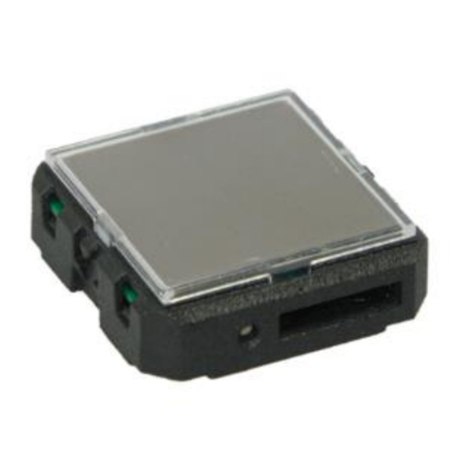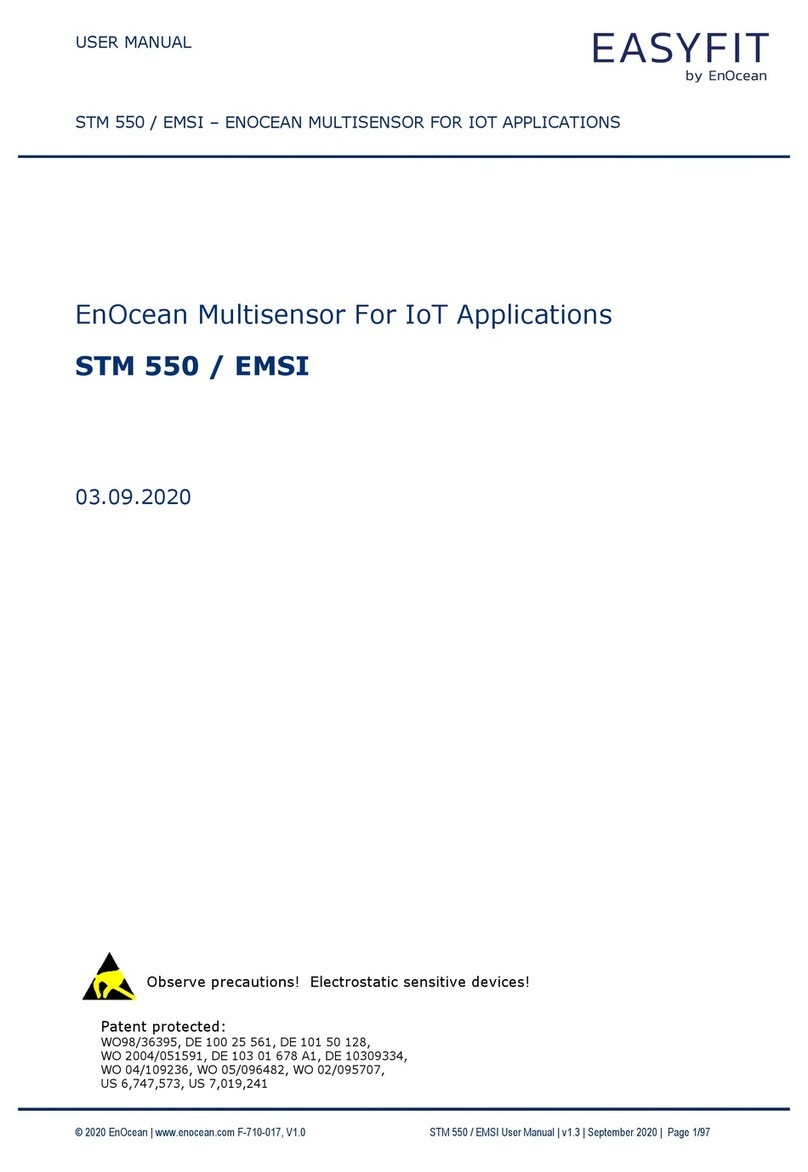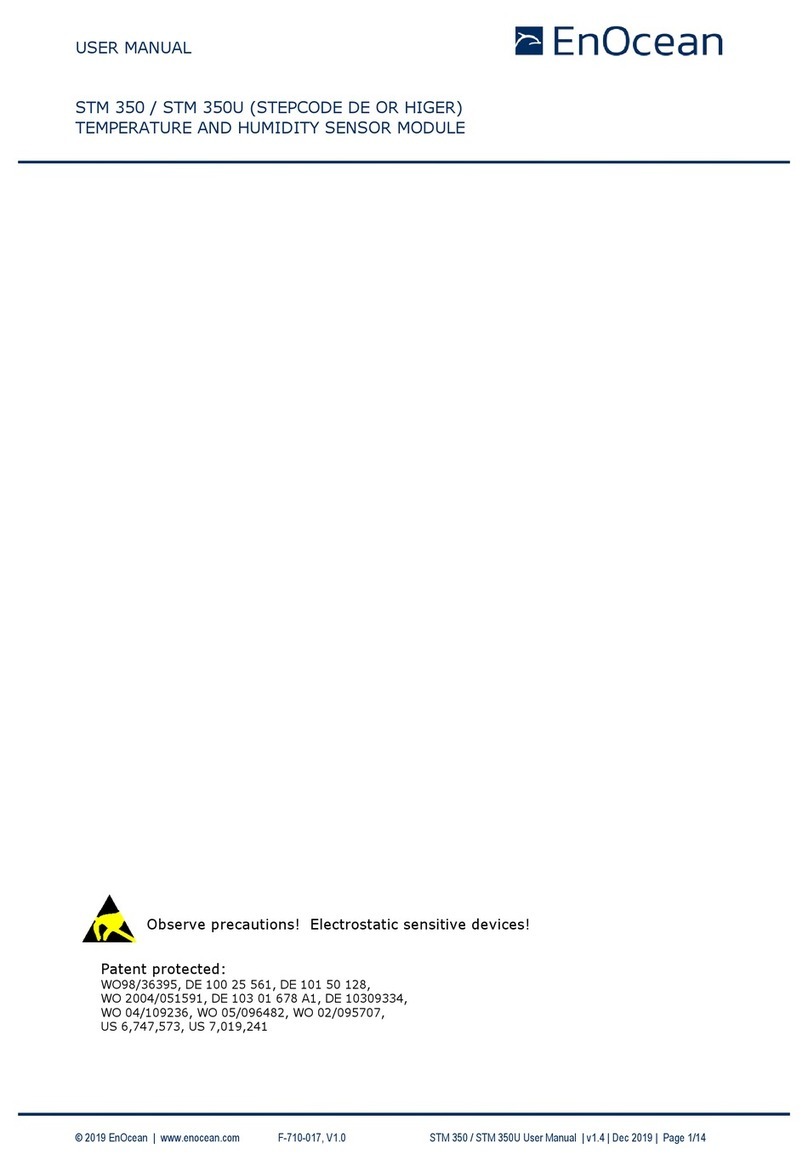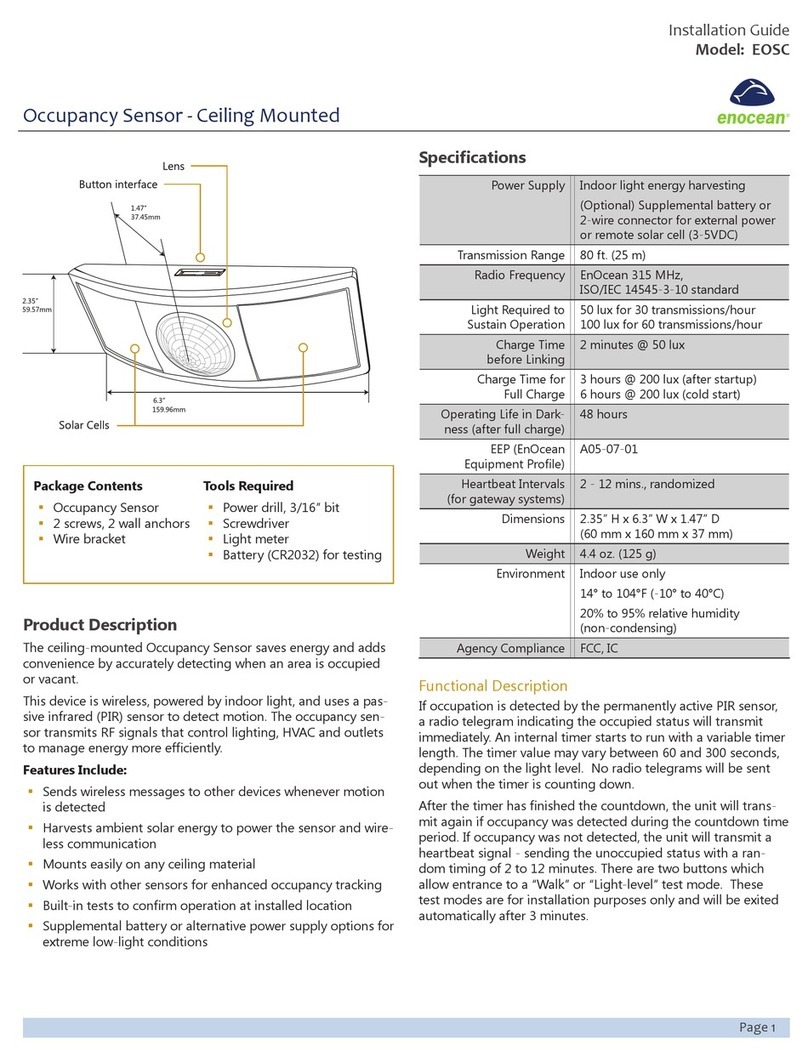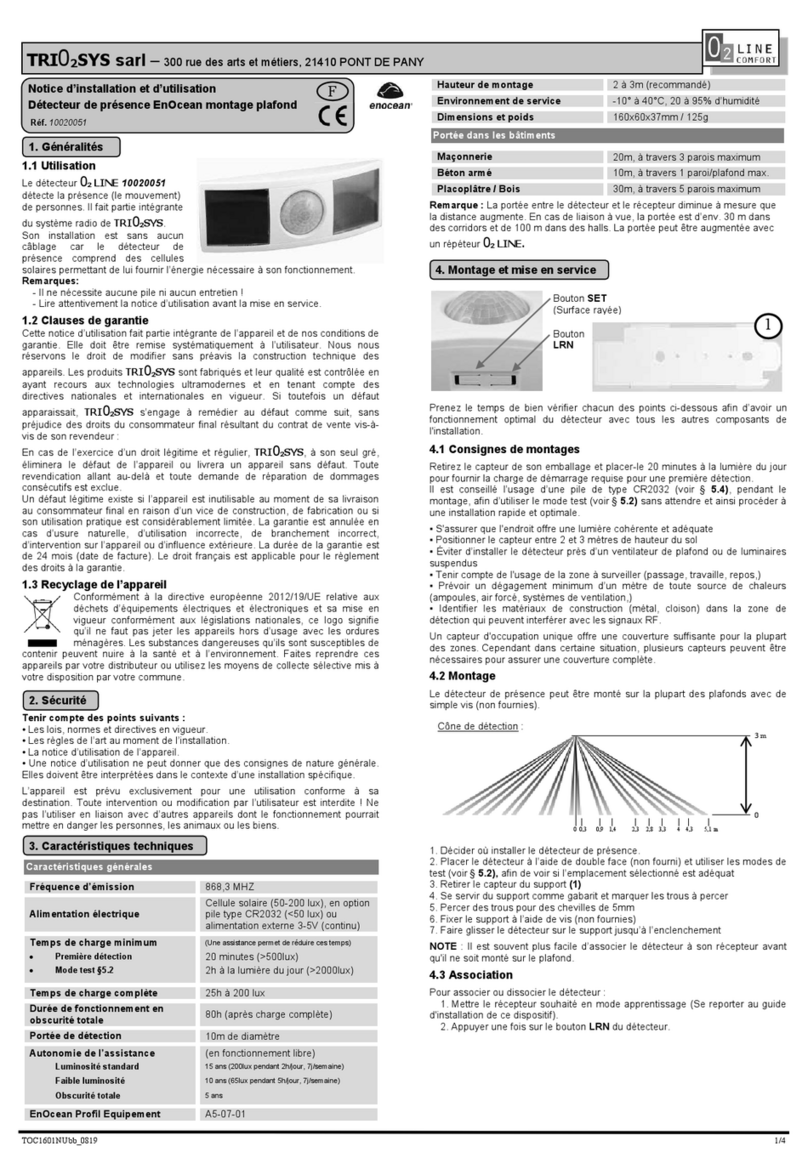EnOcean STM 550X Series User manual

USER MANUAL
STM 550X / EMSIX –ENOCEAN MULTI-SENSOR
© 2020 EnOcean | www.enocean.com F-710-017, V1.0 STM 550x / EMSIx User Manual | v1.0 | February 2020 | Page 1/79
Patent protected:
WO98/36395, DE 100 25 561, DE 101 50 128,
WO 2004/051591, DE 103 01 678 A1, DE 10309334,
WO 04/109236, WO 05/096482, WO 02/095707,
US 6,747,573, US 7,019,241
Observe precautions! Electrostatic sensitive devices!
EnOcean Multi-Sensor
STM 550x / EMSIx
19.02.2020

USER MANUAL
STM 550X / EMSIX –ENOCEAN MULTI-SENSOR
© 2020 EnOcean | www.enocean.com F-710-017, V1.0 STM 550x / EMSIx User Manual | v1.0 | February 2020 | Page 2/79
REVISION HISTORY
The following major modifications and improvements have been made to this document:
Version
Author
Reviewer
Date
Major Changes
1.0
MKA
TM, EM,
MH, MF
19.02.2020
First public release
Published by EnOcean GmbH, Kolpingring 18a, 82041 Oberhaching, Germany
www.enocean.com, info@enocean.com, phone +49 (89) 6734 6890
© EnOcean GmbH, All Rights Reserved
Important!
This information describes the type of component and shall not be considered as assured
characteristics. No responsibility is assumed for possible omissions or inaccuracies. Circuitry
and specifications are subject to change without notice. For the latest product specifications,
refer to the EnOcean website: http://www.enocean.com.
As far as patents or other rights of third parties are concerned, liability is only assumed for
modules, not for the described applications, processes and circuits.
EnOcean does not assume responsibility for use of modules described and limits its liability
to the replacement of modules determined to be defective due to workmanship. Devices or
systems containing RF components must meet the essential requirements of the local legal
authorities.
The modules must not be used in any relation with equipment that supports, directly or
indirectly, human health or life or with applications that can result in danger for people,
animals or real value.
Components of the modules are considered and should be disposed of as hazardous waste.
Local government regulations are to be observed.
Packing: Please use the recycling operators known to you.

USER MANUAL
STM 550X / EMSIX –ENOCEAN MULTI-SENSOR
© 2020 EnOcean | www.enocean.com F-710-017, V1.0 STM 550x / EMSIx User Manual | v1.0 | February 2020 | Page 3/79
TABLE OF CONTENT
1General description........................................................................................6
1.1 Basic functionality .........................................................................................6
1.2 Product variants ............................................................................................7
1.3 Technical data...............................................................................................7
1.4 Environmental conditions ...............................................................................8
1.5 Packaging information....................................................................................8
1.5.1 STM 550x .............................................................................................8
1.5.2 EMSIx .................................................................................................. 8
1.6 Ordering information ..................................................................................... 8
2Functional overview .......................................................................................9
2.1Product description ........................................................................................ 9
2.2 Product interface ...........................................................................................9
2.2.1 LRN button and LED ............................................................................. 10
2.2.2 Solar cell ............................................................................................ 11
2.2.3 Backup battery .................................................................................... 11
2.2.4 Product label ....................................................................................... 11
2.3 Functional modes ........................................................................................ 12
2.3.1 Standard operation mode ..................................................................... 12
2.3.2 Standby (Sleep) mode.......................................................................... 13
2.3.3 Learn mode......................................................................................... 13
2.3.4 Function test mode .............................................................................. 13
2.3.5 Illumination test mode ......................................................................... 14
2.3.6 Factory reset mode .............................................................................. 14
2.4 Reporting interval........................................................................................ 15
2.4.1 Energy considerations .......................................................................... 15
2.4.2 Standard reporting interval ................................................................... 16
2.4.3 Illumination-controlled reporting interval ................................................ 17
2.4.4 Temperature-controlled reporting interval ............................................... 18
2.4.5 Humidity-controlled reporting interval .................................................... 19
2.4.6 Acceleration-controlled reporting interval ................................................ 20
2.4.7 Magnet contact sensor-controlled reporting interval ................................. 21
2.4.8 Arbitration between reporting intervals ................................................... 21
3Sensor functionality ..................................................................................... 22
3.1 Light level sensor ........................................................................................ 22
3.2 Solar cell .................................................................................................... 22
3.3 Temperature sensor..................................................................................... 23
3.4 Humidity sensor .......................................................................................... 23
3.5 Acceleration sensor...................................................................................... 24
3.5.1 Wake on acceleration ........................................................................... 25
3.5.2 Acceleration sensor parameters ............................................................. 25
3.6 Magnet contact sensor ................................................................................. 26
4Radio communication................................................................................... 27
4.1 Radio Frame format ..................................................................................... 27
4.1.1 ERP1 frame format .............................................................................. 27

USER MANUAL
STM 550X / EMSIX –ENOCEAN MULTI-SENSOR
© 2020 EnOcean | www.enocean.com F-710-017, V1.0 STM 550x / EMSIx User Manual | v1.0 | February 2020 | Page 4/79
4.1.2 ERP2 frame format .............................................................................. 27
4.2 EnOcean Equipment Profiles (EEP) and SIGNAL telegrams ................................ 28
4.2.1 STM 550x supported EEP ...................................................................... 28
4.2.2 EEP structure ...................................................................................... 29
4.2.3 1BS telegram ...................................................................................... 30
4.2.4 4BS telegram ...................................................................................... 30
4.2.5 VLD telegram ...................................................................................... 30
4.2.6 UTE (Universal Teach-in) telegram......................................................... 30
4.2.7 Signal telegram ................................................................................... 31
5Security ..................................................................................................... 32
5.1 Basic concepts ............................................................................................ 32
5.1.1 Telegram encryption ............................................................................ 32
5.1.2 Telegram authentication ....................................................................... 33
5.1.3 Dynamic security key modification ......................................................... 34
5.2 Security parameters .................................................................................... 35
5.2.1 EURID ................................................................................................ 35
5.2.2 Security key........................................................................................ 35
5.2.3 Rolling code and signature (CMAC) type ................................................. 35
5.3 STM 550x security implementation ................................................................ 36
6Commissioning............................................................................................ 37
6.1 Radio-based commissioning.......................................................................... 38
6.2 QR code commissioning ............................................................................... 38
6.3 Commissioning via NFC interface................................................................... 38
7NFC interface .............................................................................................. 39
7.1 NFC interface parameters ............................................................................. 39
7.2 NFC access protection .................................................................................. 39
7.3 Using the NFC interface................................................................................ 40
7.4 NFC interface functions ................................................................................ 41
7.4.1 NFC interface state machine.................................................................. 41
7.4.2 IDLE state........................................................................................... 42
7.4.3 READY 1 state ..................................................................................... 42
7.4.4 READY 2 state ..................................................................................... 42
7.4.5 ACTIVE state....................................................................................... 42
7.4.6 Read command ................................................................................... 43
7.4.7 Write command ................................................................................... 43
7.4.8 Password authentication (PWD_AUTH) command ..................................... 44
8NFC registers .............................................................................................. 45
8.1 NFC memory areas ...................................................................................... 45
8.2 Device identification NDEF ............................................................................ 46
8.3 User information NDEF ................................................................................. 46
8.4 NFC HEADER............................................................................................... 47
8.4.1 NFC HEADER area structure .................................................................. 47
8.5 CONFIGURATION......................................................................................... 48
8.5.1 Using the NFC configuration functionality ................................................ 48
8.5.2 CONFIGURATION area structure ............................................................ 48
8.5.3 NFC_PIN_CODE ................................................................................... 49

USER MANUAL
STM 550X / EMSIX –ENOCEAN MULTI-SENSOR
© 2020 EnOcean | www.enocean.com F-710-017, V1.0 STM 550x / EMSIx User Manual | v1.0 | February 2020 | Page 5/79
8.5.4 PRODUCT_ID ...................................................................................... 49
8.5.5 USER_KEY .......................................................................................... 50
8.5.6 SECURITY_KEY_MODE.......................................................................... 50
8.5.7 SECURITY_MODE................................................................................. 51
8.5.8 EEP .................................................................................................... 52
8.5.9 SIGNAL .............................................................................................. 53
8.5.10 LED_MODE ......................................................................................... 54
8.5.11 FUNCTIONAL_MODE............................................................................. 55
8.5.12 STANDARD_TX_INTERVAL .................................................................... 56
8.5.13 THRESHOLD_CFG1............................................................................... 57
8.5.14 THRESHOLD_CFG2............................................................................... 59
8.5.15 LIGHT_SENSOR_CFG ........................................................................... 60
8.5.16 ACC_SENSOR_CFG .............................................................................. 61
8.5.17 SOLAR_THRESHOLD............................................................................. 62
8.5.18 SOLAR_TX_INTERVAL .......................................................................... 63
8.5.19 LIGHT_THRESHOLD ............................................................................. 64
8.5.20 LIGHT_TX_INTERVAL ........................................................................... 65
8.5.21 ACCELERATION_THRESHOLD ................................................................ 66
8.5.22 ACCELERATION_TX_INTERVAL .............................................................. 67
8.5.23 TEMPERATURE_THRESHOLD ................................................................. 68
8.5.24 TEMPERATURE_TX_INTERVAL ............................................................... 69
8.5.25 HUMIDITY_THRESHOLD........................................................................ 70
8.5.26 HUMIDITY_TX_INTERVAL...................................................................... 71
8.5.27 MAGNET_CONTACT_TX_INTERVAL......................................................... 72
8.5.28 ILLUMINATION_TEST_RESULT............................................................... 73
8.6 USER DATA ................................................................................................ 73
9Installation recommendations ....................................................................... 74
9.1Setup instructions ....................................................................................... 74
9.2 Acceleration detection .................................................................................. 75
9.3 Temperature and humidity measurement ....................................................... 76
9.4 Illumination measurement ............................................................................ 77
9.4.1 Ambient light sensor ............................................................................ 77
9.4.2 Solar cell ............................................................................................ 77
9.5 Magnet contact sensing................................................................................ 78
9.6 Energy harvesting ....................................................................................... 78
9.7 NFC configuration ........................................................................................ 78
10 Product history............................................................................................ 79

USER MANUAL
STM 550X / EMSIX –ENOCEAN MULTI-SENSOR
© 2020 EnOcean | www.enocean.com F-710-017, V1.0 STM 550x / EMSIx User Manual | v1.0 | February 2020 | Page 6/79
1General description
This user manual describes the functionality of the family of multisensor modules STM 550x
and the family of Easyfit multisensor products EMSIx. An EMSIx Easyfit multisensor combines
an STM 550x module with a wall mount, a cover frame, a magnet and an adhesive mounting
tape into a ready to use product.
The STM 550x / EMSIx multisensor family consists of the following members:
◼STM 550 and EMSIA using 868.3 MHz radio (main market Europe)
◼STM 550U and EMSIU using 902.875 MHz radio (main market US / Canada)
◼STM 550J and EMSIJ using 928.35 MHz radio (main market Japan)
The term “STM 550x” is used throughout this user manual to describe both EMSIx Easyfit
multisensors and STM 550x multisensor modules in all frequency variants unless otherwise
noted.
1.1 Basic functionality
STM 550x is a flexible self-powered multi-sensor module family capable of measuring tem-
perature, humidity, illumination, magnet contact status and acceleration. It enables the re-
alization of energy harvesting wireless sensors for light, building or industrial control systems
communicating using the EnOcean radio standard.
STM 550x uses the same mechanical form factor as the industry standard PTM 21x modules
from EnOcean.
STM 550x implements the following sensors:
◼Temperature
◼Humidity
◼Illumination
◼Acceleration
◼Magnet contact
STM 550x will report periodically (by default approximately every 60 seconds, configurable
via NFC) the latest measurements of these sensors. In addition, STM 550x can also report
its internal energy level and the amount of light available at the solar cell.
STM 550x will report immediately if the status (open / closed) of the magnet contact changes
or if a change in acceleration measured by the acceleration sensor exceeds a user-defined
threshold for the first time.
Radio telegrams transmitted by STM 550x can be encrypted and authenticated using AES-
128 security based on a device-unique private key and a sequence counter in accordance to
the EnOcean Alliance Security Specification. This ensures integrity, confidentiality and au-
thenticity of the transmitted telegrams and prevents telegram replay (retransmission of pre-
viously transmitted telegrams).
STM 550x is self-supplied via an integrated solar cell which generates the energy required
for its operation. For cases where ambient light is not sufficiently available, STM 550x pro-
vides the option to mount a CR1632 backup battery.

USER MANUAL
STM 550X / EMSIX –ENOCEAN MULTI-SENSOR
© 2020 EnOcean | www.enocean.com F-710-017, V1.0 STM 550x / EMSIx User Manual | v1.0 | February 2020 | Page 7/79
1.2 Product variants
EMSIx is a finished product combining STM 550x with a wall mount, a design frame, a magnet
(for magnet sensor functionality) and an adhesive mounting tape into a ready to use product.
STM 550x is the functional module within EMSIx using the PTM 21x form factor intended to
be integrated into an OEM housing (e.g. a switch frame). STM 550x and EMSIx are shown in
Figure 1 below.
Figure 1 –STM 550x and EMSIx
1.3 Technical data
Antenna
Integrated helix antenna
Transmission frequency / power
STM 550 / EMSIA: 868.300 MHz / +5 dBm
STM 550U / EMSIU: 902.875 MHz / + 99 dBµV
STM 550J / EMSIJ: 928.350 MHz / 0 dBm
Transmission data rate
125 kbit / s
Communication range (for guidance only)
200 m free field
30 m indoor environment
Temperature measurement range / accuracy
-20 °C … +60 °C / +- 0.3 K (1)
Humidity measurement range / accuracy
0 … 100 % r.h. / +- 3% r.h. (1)
Illumination measurement range / accuracy
0 … 65000 lux / +-10 %
Acceleration measurement range / accuracy
+- 2 g / +-0.03 g
Acceleration threshold for immediate report
0.03 g (default, configurable via NFC)
Update rate (excl. random offset)
Every 60 seconds (configurable via NFC)
Device configuration
LRN button and NFC interface
Supported EEP (selectable via NFC)
D2-14-41 (default)
D2-14-40, A5-02-05, A5-04-01, A5-04-03
A5-06-02, A5-06-03, A5-14-05, D5-00-01
Power supply
Integrated solar cell
Operating time in darkness
4 days (after full charge)
Backup power supply (optional)
CR1632
Dimensions (STM 550x Module)
40 mm x 40 mm x 13 mm
Dimensions (EMSIx Finished product)
49 mm x 49 mm x 13 mm
Note 1: STM 550x / EMSIx is designed for indoor use only and should only be used in the environmental
conditions specified below

USER MANUAL
STM 550X / EMSIX –ENOCEAN MULTI-SENSOR
© 2020 EnOcean | www.enocean.com F-710-017, V1.0 STM 550x / EMSIx User Manual | v1.0 | February 2020 | Page 8/79
1.4 Environmental conditions
Operating Temperature
-5 °C … +45 °C (indoor use in dry rooms only)
Humidity
0% to 90% r.h. (non-condensing)
1.5 Packaging information
1.5.1 STM 550x
Packaging Unit 100 units
Packaging Method 10 modules per tray, 10 trays per box
1.5.2 EMSIx
Packaging Unit Individual unit packaging
Packaging Method TBD packages within one box
1.6 Ordering information
Type
Ordering Code
Frequency
STM 550 (Module)
EMSIA (Finished Product)
S6201-K516
E6201-K516
868.300 MHz
STM 550U (Module)
EMSIU (Finished Product)
S6251-K516
E6251-K516
902.875 MHz
STM 550J (Module)
EMSIJ (Finished Product)
S6261-K516
E6261-K516
928.350 MHz

USER MANUAL
STM 550X / EMSIX –ENOCEAN MULTI-SENSOR
© 2020 EnOcean | www.enocean.com F-710-017, V1.0 STM 550x / EMSIx User Manual | v1.0 | February 2020 | Page 9/79
2Functional overview
2.1 Product description
The energy-harvesting multi-sensor STM 550x using the STM 550x multisensor module pro-
vides wireless sensing functionality without batteries. Power is provided by a connected solar
cell. STM 550x transmits sensor data using the EnOcean radio standard.
STM 550x operates fully self-powered (no batteries required) when sufficient available am-
bient light (200 Lux for 6 hours per day) is available. In this configuration it is fully mainte-
nance-free.
For cases where sufficient ambient light is not available there is the option to mount a CR1632
backup battery.
Radio telegrams transmitted by STM 550x can be authenticated and encrypted using AES-
128 security based on a device-unique private key and a sequence counter in accordance to
the EnOcean Alliance Security Specification. This ensures integrity, confidentiality and au-
thenticity of the transmitted telegrams and prevents telegram replay (retransmission of pre-
viously transmitted telegrams).
2.2 Product interface
The STM 550x product interface consists of the following elements:
◼LRN button and LED as described in chapter 2.2.1
◼Solar cell harvesting energy from ambient light as described in chapter 2.2.2
◼Ambient light sensor (co-located with the LED) as described in chapter 3.
◼Magnet contact sensor as described in chapter 3.6
◼Ventilation slots to ensure airflow to the temperature and humidity sensor
◼Backup battery slot for a CR1632 battery as described in chapter 2.2.3
◼Backup battery ejector slot (on the back side) as described in chapter 2.2.3
◼Product label (on the back side) as described in chapter 2.2.4
Figure 2 below shows the external interfaces on the front side of the STM 550x module.
Figure 2 –STM 500x external interfaces

USER MANUAL
STM 550X / EMSIX –ENOCEAN MULTI-SENSOR
© 2020 EnOcean | www.enocean.com F-710-017, V1.0 STM 550x / EMSIx User Manual | v1.0 | February 2020 | Page 10/79
Figure 3 below shows the external interfaces on the back side of the STM 550x module within
EMSIx. The orientation indicator points towards the side where the magnet contact is located.
Figure 3 –STM 550x product interface (back side)
2.2.1 LRN button and LED
Most STM 550x device parameters can be configured using the NFC interface as described in
chapter 8. Some of the most common parameters or states can additionally be configured
using the LRN button.
Table 1 below lists those LRN button actions with the corresponding STM 550x response and
LED feedback.
Type
LRN Button Action
STM 550x Response
LED Feedback
Single
Short
Press LRN button once
(< 1s)
Exit from Sleep Mode
Send Learn Telegram
1 short blink
Double
Short
Press LRN button
twice within 1s
Start Function Test
(End after 2 min or upon
any button press)
Transmit sensor status
with highest possible update
rate
Triple
Short
Press LRN button
three times within 2s
Toggle LED indication
LED enabled: 2 short blinks
LED disabled: No feedback
Single
Long
Press LRN button once
for 3s …5s
Enter Sleep Mode
(Disable LED and Radio)
Error: No feedback
Success: 3 short blinks
Double
Long
Press LRN button
twice for 3s … 5s
Enter High Security Mode
(Encrypt and authenticate)
Error: No feedback
Success: 3 short blinks
Very
Long
Press LRN button for >
8s
Factory Reset
Error: No feedback
Success: 5 short blinks
Table 1 –STM 550x user interface actions

USER MANUAL
STM 550X / EMSIX –ENOCEAN MULTI-SENSOR
© 2020 EnOcean | www.enocean.com F-710-017, V1.0 STM 550x / EMSIx User Manual | v1.0 | February 2020 | Page 11/79
2.2.2 Solar cell
The solar cell harvests energy from ambient light. The spectral response of the solar cell is
optimized to harvest energy both from natural and from artificial light. The amount of avail-
able light influences the available power and thereby the possible update rate of STM 550x
as discussed in chapter 2.4.1. The device should therefore be installed such that the amount
of light available to the solar cell is maximized.
2.2.3 Backup battery
STM 550x provides a backup battery interface to mount a CR1632 battery for cases with
insufficient ambient light. The backup battery has to be installed with the positive pole point-
ing upwards (i.e. towards the side of the solar cell).
EnOcean recommends Renata CR1632 due to its low self-discharge and high capacity. Gloves
should be used when installing a backup battery to avoid contamination of the isolation area
between the contacts that could lead to a higher self-discharge.
The backup battery can be removed (ejected) by using a small, non-conductive item (e.g.
wooden toothpick) to push the battery out.
Do not insert any tools into the battery slot or the battery ejection slot! Doing so
could create a short circuit or damage the PCB resulting in permanent damage!
2.2.4 Product label
Each STM 550x module contains a product label with a commissioning QR code. Figure 4
shows the STM 550 product label. STM 550U and STM 550J use the same label structure.
Note the commissioning QR code (described in chapter 6.2) is on the bottom left side.
Figure 4 –STM 550 product label

USER MANUAL
STM 550X / EMSIX –ENOCEAN MULTI-SENSOR
© 2020 EnOcean | www.enocean.com F-710-017, V1.0 STM 550x / EMSIx User Manual | v1.0 | February 2020 | Page 12/79
2.3 Functional modes
STM 550x supports six types of functional modes:
◼Standard operation mode
◼Standby (Sleep) mode
◼Learn mode
◼Function test mode
◼Illumination test mode
◼Factory reset mode
Out of the box, STM 550x will be in standby mode to conserve energy during
transport and storage. Upon initial setup, STM 550x has to be set to standard op-
eration mode by pressing the LRN button shortly as described in chapter 9.1 or
via the NFC interface as described in chapter 8.5.11
2.3.1 Standard operation mode
During standard operation, STM 550x wakes up periodically and reports the current sensor
status using data telegrams.
The STM 550x wake-up timer is by default configured to wake-up STM 550x approximately
every 60 seconds. If acceleration exceeding the configured threshold is detected for the first
time after a period without exceeding this threshold then STM 550x wakes up immediately
(wake on acceleration event).
Likewise, if the status of the magnet contact changes (from open to closed or vice versa)
then this is reported immediately as well (wake on magnet contact event).
The wake-up intervals are affected at random (i.e. a small random offset is added or sub-
tracted) in order to increase the robustness of the radio transmission and to comply with
regulatory requirements.

USER MANUAL
STM 550X / EMSIX –ENOCEAN MULTI-SENSOR
© 2020 EnOcean | www.enocean.com F-710-017, V1.0 STM 550x / EMSIx User Manual | v1.0 | February 2020 | Page 13/79
2.3.2 Standby (Sleep) mode
Standby (sleep) mode is the lowest power mode of STM 550x and is the out of the box state
of STM 550x upon delivery. It is intended to be used during extended periods without oper-
ation such as device storage or transport.
In standby mode, STM 550x stops operation and conserves as much energy as possible. All
functionality –except those needed to return to standard operation mode –are disabled in
this mode.
Standby mode can be selected using the LRN button as described in chapter 2.2.1 or using
the MODE field of the FUNCTIONAL_MODE NFC register as described in chapter 8.5.11.
2.3.3 Learn mode
In learn mode, STM 550x will transmit a Teach-in telegram to communicate the device source
address and security key to a receiver. After that transmission, STM 550x will return back to
standard operation mode.
Learn mode can be selected using the LRN button as described in chapter 2.2.1 or using the
MODE field of the FUNCTIONAL_MODE NFC register as described in chapter 8.5.11.
2.3.4 Function test mode
In Function Test Mode, STM 550x will measure and report the status of the integrated sensors
at the highest possible rate to verify the sensor functionality.
STM 550x can be set into function test mode via the LRN button as described in chapter 2.2.1
or via the MODE field of the FUNCTIONAL_MODE NFC register as described in chapter 8.5.11.
Function Test Mode will be active for 120 seconds unless the LRN button is pressed before or
the functional mode is changed via the NFC interface.

USER MANUAL
STM 550X / EMSIX –ENOCEAN MULTI-SENSOR
© 2020 EnOcean | www.enocean.com F-710-017, V1.0 STM 550x / EMSIx User Manual | v1.0 | February 2020 | Page 14/79
2.3.5 Illumination test mode
During installation, STM 550x can measure and report the amount of ambient light available
at its solar cell in order to determine a suitable installation location as discussed in chapter
9.5.
Upon activation of light test mode, STM 550x will first wait for 15 seconds so that the installer
can leave the area to ensure a relevant measurement result.
After that, STM 550x will take measurements of the ambient light level using its solar cell
every 5 seconds for a period of one minute and compute the average illumination based on
those measurements.
The computed average illumination is then available in the NFC register ILLUMINA-
TION_TEST_RESULT as described in chapter 8.5.28.
Illumination test mode can be selected using the MODE field of the FUNCTIONAL_MODE NFC
register as described in chapter 8.5.11.
2.3.6 Factory reset mode
STM 550x can be reset to its standard settings using factory reset mode. Upon entering this
mode, STM 550x will reset all configuration registers to their default settings and then restart
operation in standard operation mode.
Factory reset mode can be selected using the LRN button as described in chapter 2.2.1 or
using the MODE field of the FUNCTIONAL_MODE NFC register as described in chapter 8.5.11.

USER MANUAL
STM 550X / EMSIX –ENOCEAN MULTI-SENSOR
© 2020 EnOcean | www.enocean.com F-710-017, V1.0 STM 550x / EMSIx User Manual | v1.0 | February 2020 | Page 15/79
2.4 Reporting interval
STM 550x will transmit its status as data telegram at a regular interval, the so-called report-
ing interval. By default, the reporting interval is 60 seconds, i.e. STM 550x will measure and
report its status approximately once per minute.
STM 550x is designed to apply fluctuations up to +-10% to any configured reporting interval
to increase transmission reliability and meet regulatory requirements.
If STM 550x is configured to report acceleration, then it will always report the initial acceler-
ation detection after a period without detected acceleration immediately. Likewise, if STM
550x is configured to report magnet contact status, then it will report any change in the
status of the magnet contact sensor (open -> closed or closed -> open) immediately.
2.4.1 Energy considerations
The default reporting interval of 60 seconds (one update per minute) is adjustable using the
NFC interface as discussed in the subsequent chapters. The minimum possible reporting in-
terval is 3 seconds and the maximum possible transmission interval is 65535 seconds.
Lowering the reporting interval of STM 550x will increase its power consumption since it will
measure and transmit more often. Likewise, increasing the reporting interval of STM 550x
will reduce its power consumption since it will measure and transmit less often.
To select the right reporting interval, it is essential to determine the amount of harvestable
energy. STM 550x harvests energy from the available ambient light; therefore, the amount
of available energy is determined mainly by the intensity of the available light and the amount
of time during which the light is available.
The amount of available ambient light can be determined by executing an illumination test
as described in chapter 2.3.5. The light availability period (the time during which the ambient
light is available) has to be determined based on the lighting scheme used for the environ-
ment where STM 550x is installed.
STM 550x is designed to provide one update per minute based on 200 lux of ambient light
available for 6 hours per day. The minimum supported update interval for self-supplied op-
eration based on other conditions is summarized in Table 2 below.
6 hrs / day
8 hrs / day
10 hrs / day
12 hrs / day
50 lux
Not supported
Not supported
180 s
120 s
100 lux
120 s
90 s
90 s
60 s
150 lux
90 s
60 s
60 s
45 s
200 lux
60 s
45 s
45 s
30 s
300 lux
45 s
30 s
30 s
20 s
400 lux
30 s
25 s
25 s
15 s
500 lux
25 s
20 s
20 s
15 s
Table 2 –Minimum self-supplied reporting intervals

USER MANUAL
STM 550X / EMSIX –ENOCEAN MULTI-SENSOR
© 2020 EnOcean | www.enocean.com F-710-017, V1.0 STM 550x / EMSIx User Manual | v1.0 | February 2020 | Page 16/79
2.4.2 Standard reporting interval
The standard reporting interval determines the default interval between two status updates
of STM 550x.
The standard reporting interval can be adjusted using the STANDARD_TX_INTERVAL NFC
register as described in chapter 8.5.12. Consider the available energy before lowering the
reporting interval as discussed in chapter 2.4.1.
The default setting for the standard reporting interval is one status update once every 60
seconds (1 minute).
Figure 5 below illustrates the use of the standard reporting interval.
STANDARD_TX_INTERVAL STANDARD_TX_INTERVAL
Figure 5 –Standard reporting interval
STM 550x can be configured to use a lower reporting interval, i.e. provide updates more
often, based on certain conditions as described below.

USER MANUAL
STM 550X / EMSIX –ENOCEAN MULTI-SENSOR
© 2020 EnOcean | www.enocean.com F-710-017, V1.0 STM 550x / EMSIx User Manual | v1.0 | February 2020 | Page 17/79
2.4.3 Illumination-controlled reporting interval
If sufficient ambient light is available, then it might be desirable to receive status updates
more often. For this, there are typically two main use cases:
◼Adjust the update rate based on the ambient light available for harvesting
◼Report more often during daytime (or when an office is lit) and less often during
night-time (or when an office is dark) to adapt the reporting to the usage pattern
In both cases, the higher update rate would be used whenever the ambient light level is
above a certain threshold. Figure 6 below illustrated the use of the illumination-controlled
reporting interval.
STANDARD_TX_INTERVAL SOLAR_CELL_TX_INTERVAL STANDARD_TX_INTERVALSOLAR_CELL_TX_INTERVAL
LIGHT_SENSOR_TX_INTERVAL LIGHT_SENSOR_TX_INTERVAL
Figure 6 –Illumination-controlled reporting interval
STM 550x can use either the light level at the solar cell (harvested energy) or the light level
at the ambient light sensor to trigger a higher update rate. To enable this feature, use the
following steps:
1. Configure the desired light level threshold either for the solar cell or the ambient
light sensor using either the SOLAR_THRESHOLD or LIGHT_THRESHOLD registers
described in chapters 8.5.17 and 8.5.19 respectively
2. Configure the desired reporting interval using either the SOLAR_TX_INTERVAL or
the LIGHT_TX_INTERVAL registers described in chapters 8.5.18 and 8.5.20 respec-
tively
3. Enable the use of the defined parameters using the SOLAR CELL and LIGHT SENSOR
bit fields in the THRESHOLD_CFG1 register of the NFC interface as defined in chap-
ter 8.5.13.
Consider the available energy before lowering the reporting interval as discussed in chapter
2.4.1.

USER MANUAL
STM 550X / EMSIX –ENOCEAN MULTI-SENSOR
© 2020 EnOcean | www.enocean.com F-710-017, V1.0 STM 550x / EMSIx User Manual | v1.0 | February 2020 | Page 18/79
2.4.4 Temperature-controlled reporting interval
In HVAC (heating, ventilation, air conditioning) applications it might be desirable to receive
status updates more often if the measured temperature is significantly above or below the
target value.
Figure 7 below illustrates the use of the temperature-controlled reporting interval.
Figure 7 –Temperature-controlled reporting interval
STM 550x can use the temperature measured by the temperature and humidity sensor to
trigger a higher update rate. To enable this feature, use the following steps:
1. Make sure that the EEP selected using the EEP register as described in chapter 8.5.8
reports the measured temperature
2. Configure the desired temperature threshold using the TEMPERATURE_THRESHOLD
register described in chapter 8.5.23
3. Configure the desired reporting interval using the TEMPERATURE_TX_INTERVAL reg-
ister described in chapter 8.5.24
4. Enable the use of the defined parameters using the TEMP SENSOR bit field in the
THRESHOLD_CFG1 register of the NFC interface as defined in chapter 8.5.13.
Consider the available energy before lowering the reporting interval as discussed in chapter
2.4.1.

USER MANUAL
STM 550X / EMSIX –ENOCEAN MULTI-SENSOR
© 2020 EnOcean | www.enocean.com F-710-017, V1.0 STM 550x / EMSIx User Manual | v1.0 | February 2020 | Page 19/79
2.4.5 Humidity-controlled reporting interval
In HVAC (heating, ventilation, air conditioning) applications it might be desirable to receive
status updates more often if the measured humidity is significantly above or below the target
value.
Figure 8 below illustrates the use of the humidity-controlled reporting interval.
Figure 8 –Humidity-controlled reporting interval
STM 550x can use the humidity measured by the temperature and humidity sensor to trigger
a higher update rate. To enable this feature, use the following steps:
1. Make sure that the EEP selected using the EEP register as described in chapter 8.5.8
reports humidity
2. Configure the desired humidity threshold using the HUMIDITY_THRESHOLD register
described in chapter 8.5.25
3. Configure the desired reporting interval using the HUMIDITY_TX_INTERVAL register
described in chapter 8.5.26
4. Enable the use of the defined parameters using the HUMIDITY SENSOR bit field in
the THRESHOLD_CFG1 register of the NFC interface as defined in chapter 8.5.13.
Consider the available energy before lowering the reporting interval as discussed in chapter
2.4.1.

USER MANUAL
STM 550X / EMSIX –ENOCEAN MULTI-SENSOR
© 2020 EnOcean | www.enocean.com F-710-017, V1.0 STM 550x / EMSIx User Manual | v1.0 | February 2020 | Page 20/79
2.4.6 Acceleration-controlled reporting interval
If an asset is in operation or it is being moved, then it might be desirable to receive status
updates more often to determine its status or location.
Figure 9 below illustrates the use of the acceleration-controlled reporting interval.
STANDARD_TX_INTERVAL ACCELERATION_TX_INTERVAL STANDARD_TX_INTERVAL
Immediately
ACCELERATION_TX_INTERVAL
Figure 9 –Acceleration-controlled reporting interval
STM 550x can use acceleration events detected by the acceleration sensor to trigger a higher
update rate. To enable this feature, use the following steps:
1. Make sure that the EEP selected using the EEP register as described in chapter 8.5.8
reports acceleration
2. Configure the acceleration sensor parameters (full scale value and sampling fre-
quency) and enable the wake-on-acceleration feature using the ACC_SENSOR_CFG
register described in chapter 8.5.16
3. Configure the desired acceleration threshold using the ACCELERATION_THRESHOLD
register described in chapter 8.5.21
4. Configure the desired reporting interval using the ACCELERATION_TX_INTERVAL
register described in chapter 8.5.22
5. Enable the use of the defined parameters using the ACCELERATION SENSOR bit field
in the THRESHOLD_CFG2 register of the NFC interface as defined in chapter 8.5.14.
Consider the available energy before lowering the reporting interval as discussed in chapter
2.4.1.
This manual suits for next models
1
Table of contents
Other EnOcean Accessories manuals
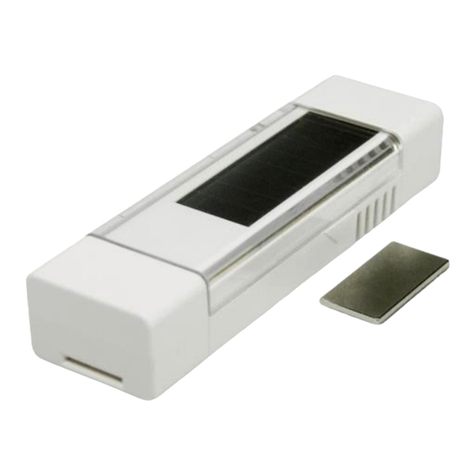
EnOcean
EnOcean EasyFit EMCSA User manual
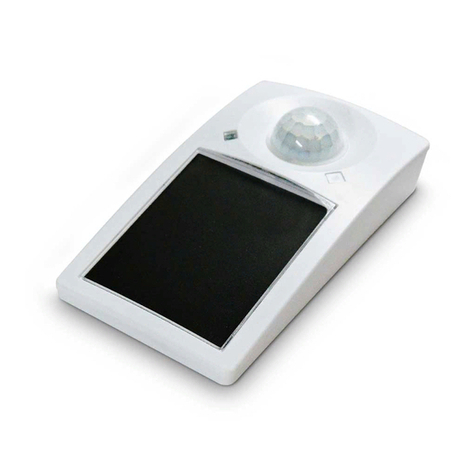
EnOcean
EnOcean Easyfit EMDC User manual
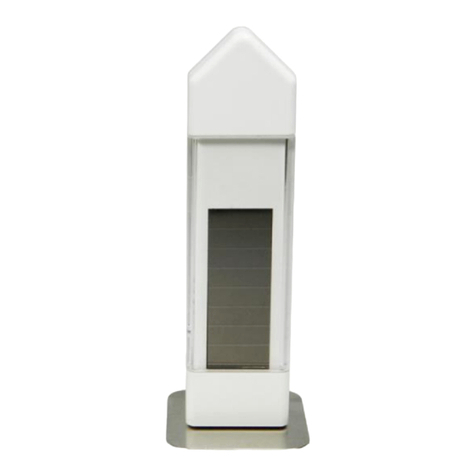
EnOcean
EnOcean Easyfit ETHSA User manual

EnOcean
EnOcean ELLS User manual

EnOcean
EnOcean EasyFit EMCSA User manual
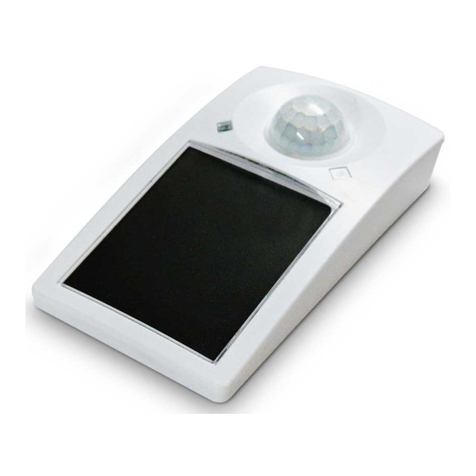
EnOcean
EnOcean EASYFIT EMDCB User manual
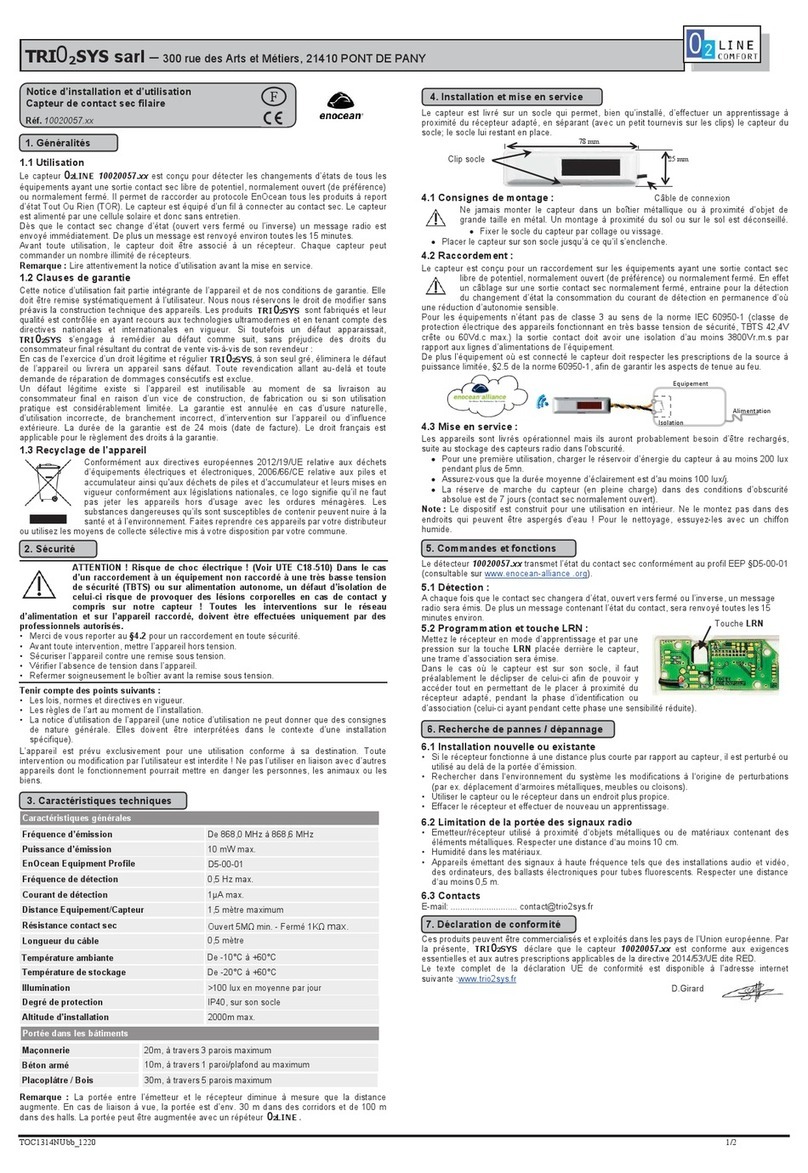
EnOcean
EnOcean 02LINE TRI02SYS User manual
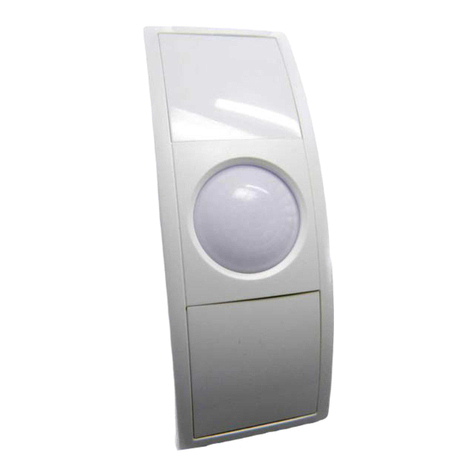
EnOcean
EnOcean Easyfit EOSD User manual

EnOcean
EnOcean 02LINE TRI02SYS User manual
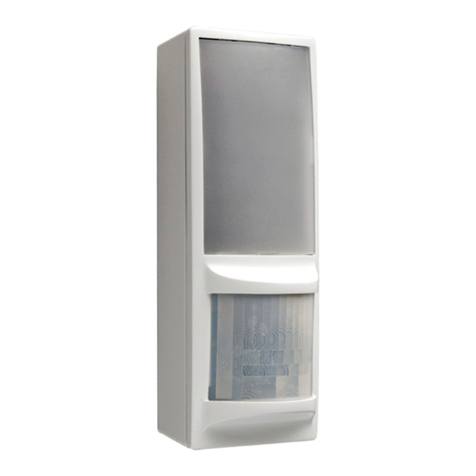
EnOcean
EnOcean EOSWU Quick start guide
